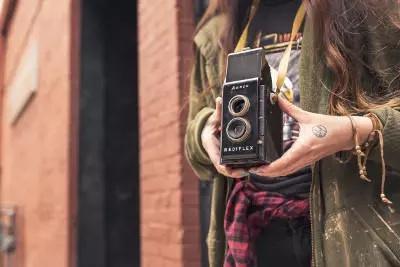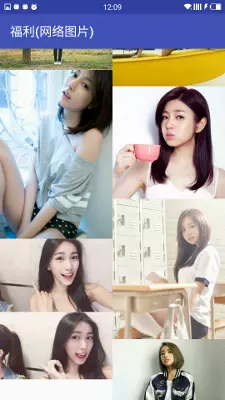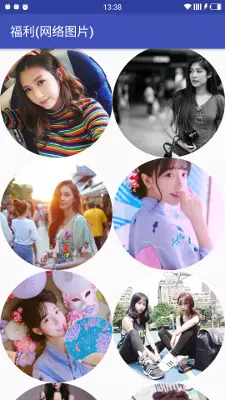Use of the Android Open Source Framework Glide - Sample Applications

Load Network Picture
- Load Network Picture
- Load Local Pictures - Simple Gallery
Load Network Picture
Introduce corresponding Libraries
compile 'com.android.support:recyclerview-v7:25.0.0' compile 'com.github.bumptech.glide:glide:3.7.0'
Create layout res/layout/fragment_list.xml for RecyclerView
<?xml version="1.0" encoding="utf-8"?>
<android.support.v7.widget.RecyclerView
xmlns:android="http://schemas.android.com/apk/res/android"
android:layout_width="match_parent"
android:layout_height="match_parent"
android:id="@+id/recycler_view"></android.support.v7.widget.RecyclerView>Layout to create each item of RecyclerView res/layout/list_item.xml
Be careful not to write match_parent or wrap_content, or the effect of waterfall flow will not be shown
<?xml version="1.0" encoding="utf-8"?>
<LinearLayout xmlns:android="http://schemas.android.com/apk/res/android"
android:orientation="vertical" android:layout_width="match_parent"
android:layout_height="wrap_content">
<ImageView
android:layout_width="match_parent"
android:layout_height="wrap_content"
android:adjustViewBounds="true"
android:id="@+id/image"/>
</LinearLayout>To create an adapter for RecyclerView, GankAdapter.java, the main code logic is as follows
@Override
public ViewHolder onCreateViewHolder(ViewGroup parent, int viewType) {
View v = LayoutInflater.from(mContext).inflate(R.layout.list_item,parent,false);
return new ViewHolder(v);
}
@Override
public void onBindViewHolder(ViewHolder holder, int position) {
final String url = mItems.get(position);
Log.e("tag","============onBindViewHolder url: "+url);
Glide.with(mContext)
.load(url)
.placeholder(R.mipmap.ic_launcher)
.diskCacheStrategy(DiskCacheStrategy.RESULT)
.into(holder.image);
holder.image.setOnClickListener(new View.OnClickListener(){
@Override
public void onClick(View v) {
Intent intent = new Intent();
intent.setClass(mContext,PreviewImageActivity.class);
intent.putExtra("url",url);
mContext.startActivity(intent);
}
});
}
@Override
public int getItemCount() {
return mItems.size();
}
public class ViewHolder extends RecyclerView.ViewHolder{
ImageView image;
public ViewHolder(View itemView) {
super(itemView);
image = (ImageView)itemView.findViewById(R.id.image);
}
}Show RecyclerView, create a Fragment to display GankFragment.java
The main display logic is as follows:
@Nullable
@Override
public View onCreateView(LayoutInflater inflater, @Nullable ViewGroup container, @Nullable Bundle savedInstanceState) {
View v = inflater.inflate(R.layout.fragment_list,container,false);
mClient = new OkHttpClient();
mReyclerView = (RecyclerView) v.findViewById(R.id.recycler_view);
mReyclerView.setLayoutManager(new StaggeredGridLayoutManager(2,StaggeredGridLayoutManager.VERTICAL));
mAdapter = new GankAdapter(getActivity(),mUrls);
mReyclerView.setAdapter(mAdapter);
loadApi(index);
mReyclerView.addOnScrollListener(new RecyclerView.OnScrollListener() {
@Override
public void onScrollStateChanged(RecyclerView recyclerView, int newState) {
super.onScrollStateChanged(recyclerView, newState);
}
@Override
public void onScrolled(RecyclerView recyclerView, int dx, int dy) {
super.onScrolled(recyclerView, dx, dy);
if(isScrollToEnd(mReyclerView)){
Log.e("tag","============scroll to end");
index += 1;
loadApi(index);
}
}
});
return v;
}A third-party library for OkHttpClient was introduced to load network pictures
compile 'com.squareup.okhttp3:okhttp:3.4.1'
Logic for loading pictures from the network
private void loadApi(int page){
Request request = new Request.Builder().url("http://gank.io/api/data/%E7%A6%8F%E5%88%A9/10/"+page).build();
mClient.newCall(request).enqueue(new Callback() {
@Override
public void onFailure(Call call, IOException e) {
Log.e("tag","loading failure ");
e.printStackTrace();
}
@Override
public void onResponse(Call call, Response response) throws IOException {
if(response.isSuccessful()){
String result = response.body().string();
try {
JSONObject json = new JSONObject(result);
JSONArray array = new JSONArray(json.getString("results"));
for(int i = 0;i<array.length();i++){
JSONObject ob = array.getJSONObject(i);
mUrls.add(ob.getString("url"));
Log.e("tag","========== url: "+ob.getString("url"));
}
mHandler.sendEmptyMessage(2);
}catch (JSONException e){
e.printStackTrace();
}
}
}
});
}
Load local pictures
Load local pictures using Glide and network pictures using the same adapter's code GankAdapter.java
Display the logical code LocalAlbumFragment.java, which primarily loads data from the local image database
private void loadAlbum(){
AsyncTask<Void, Void, Void> asyncTask = new AsyncTask<Void, Void, Void>() {
@Override
protected Void doInBackground(Void... params) {
Cursor c = getContext().getContentResolver().query(MediaStore.Images.Media.EXTERNAL_CONTENT_URI,
new String[]{MediaStore.Images.ImageColumns.DATA},null,null, MediaStore.Images.ImageColumns.DATE_TAKEN+" desc ");
if(null != c && c.getCount() > 0 && c.moveToFirst()){
while (c.moveToNext()){
mData.add(c.getString(c.getColumnIndex(MediaStore.Images.ImageColumns.DATA)));
}
}
return null;
}
@Override
protected void onPostExecute(Void aVoid) {
mHandler.sendEmptyMessage(2);
}
};
asyncTask.execute();
}
Add Image Transform
When using the Glide library, you can do some transformation on the image, such as round corners, blurring, etc., using the Glide's.bitmapTransform() method.
I need to write the corresponding transformation methods, but now there are good third-party libraries that have encapsulated some of the common transformations and can be used directly without repeating wheels
Introducing a third-party image transformation library: glide-transformations
compile 'jp.wasabeef:glide-transformations:2.0.1'
This library provides many transformations, such as crop-related, color-related, fuzzy-related, etc. See the source code for details
Try a circular effect
Glide.with(mContext)
.load(url)
.placeholder(R.mipmap.ic_launcher)
.diskCacheStrategy(DiskCacheStrategy.RESULT)
.bitmapTransform(new CropCircleTransformation(mContext)) //With a circular transformation, you can also use other transformations
.into(holder.image);
Of course, if you are not satisfied with these effects, you can write the corresponding transformation effect yourself